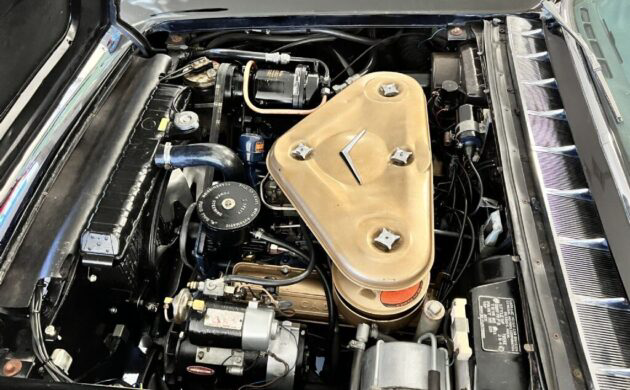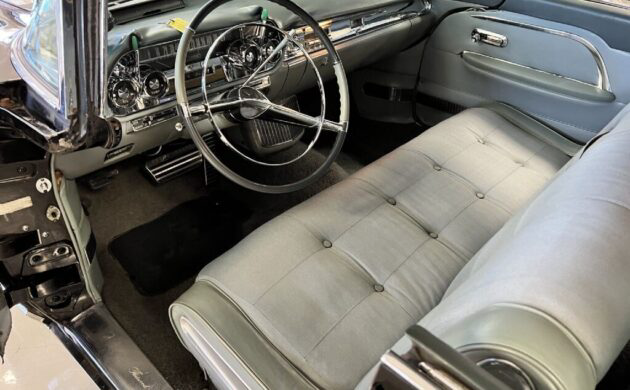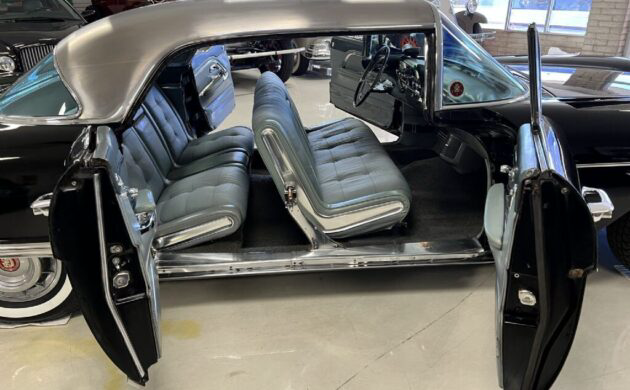The most luxurious automobile ever made by an American manufacturer emerged from General Motors’ 1953 Motorama event. The Motorama was a concept car show first held at the New York Waldorf Astoria Hotel in 1949. Later it roved all over the country, providing entertainment as well as gauging customer preferences. In 1953, GM showed a concept car called the Orleans. Flaunting hardtop styling, a wrap-around windshield, suicide doors, and vanity accessories, the Orleans was like nothing seen before. On its heels in 1954 came the Park Avenue, a similar creation. The enthusiastic reception embracing these cars was just the confirmation Harley Earl needed to set a direction for the third generation of Cadillacs. While all of Cadillac’s third-gen models were exclusive, none was more so than the Eldorado Brougham. Here on eBay is a three-owner 1957 Cadillac Eldorado Brougham with an asking price of $119,800. This car is located in Phoenix, Arizona.
The Eldorado Brougham was saturated with luxury features, from memory seats to vanity accessories (which are present as originals or replicated in the subject car), front and rear heat and air conditioning, a lockout switch to prevent the car from going into Drive while the doors were open, an Autronic Eye that dimmed the car’s headlights for oncoming traffic, automatic door locks, and over forty interior trim combinations. Unfortunately one of its features – air ride suspension – failed frequently. It was replaced in 1958 models with a conventional set-up. This car was originally equipped with air ride, but the system was swapped out for a modern RideTech suspension which works similarly. Meanwhile, in 1957 these cars were delivered with GM’s 365 cu. in. V8 rigged with dual four-barrel carburetors and a Hydra-Matic transmission. The resulting 325 bhp was necessary to motivate the 5300 lb car off the line. In 1958, horsepower increased to 335, thanks to a triple carb arrangement. This car has the later, higher horsepower motor. The seller reports that the car runs very well.
The interior is in nice condition, with a light patina affecting the chrome, knobs, lower door panels, dash covering, and a few other areas. The seller reports that the paintwork also exhibits some flaws but all are fairly minor. The clock and antenna do not work, and a few other accessories are intermittent. On the other hand, the air conditioning will run the interior temperature down into the 30s. The odometer reads 15,238 but there’s no claim that that’s true mileage.
The brushed stainless top, pillarless construction, suicide doors, low stance, and other details put the Eldorado Brougham on a special portion of GM’s assembly line. It didn’t share panels with any other Cadillac. GM lost money on every unit sold; this financial impact limited production to 704 examples. It was astonishingly expensive – the equivalent of about $120,000 today. Curiously, that’s about the price of this car. If you hanker for this model, you may have to pay the price. These cars don’t come up for sale often, particularly in driver-friendly condition rather than as an overdone restoration.






Michelle, there are a few incorrect items in your article. This isn’t the third generation of Cadillacs, air suspension was not discontinued for 1958, and despite what the eBay ad says, this car has the dual-quad V8, not the triple-2bbl from 1958. Dual-quad cars have the batwing air clearer. Triple-2bbl cars have a round air cleaner with three wing nuts.
Thanks for the corrections, appreciate it.
If I had the money I would like to find out from General Motors if the 1955 Cadillac Eldorado broom could be purchased to me that was the most beautiful Cadillac ever built Big Joe Longview Texas
Brougham ?
Let me tell you I don’t swoon over many luxury cars but these 50s Eldorado baritizs are just gorgeous cars ! Just everything working together I guess & I’m far from affording this car but if it’s everything it looks to be its worth every penny in my book! Thanks barn find for reminding us at one time Cadillac was the standard of the world! Throw a 1970 Buick Riv with a 455 not far behind IMHO
Interesting how this car is one on a very short list of prized 4 door cars throughout automotive history.
Bob Hope bought one new in ’58 and kept it until the mid-1980s. That car was featured on the old Dream Car Garage TV show out of Canada. You can see a clip with Peter Klutt driving the car on Legendary Motorcar’s YouTube channel.
You can all forget about it ! I live in Phoenix and as soon as I finish my morning coffee ,I am going to swing by the bank and go pick it up. I just have to ask my wife ,if she will give me a ride, so I can drive it home. I see no problem.
If that’s true you’re a lucky man.
The 57 Caddy is one of my all-time favorites. I had a friend who owned one, and I often got to drive it. I thought I was “king of the world” behind the wheel…. lol
$120k and they can’t fix the clock! It would be interesting to know what GM used for the memory of the memory seat function back in 57!
Gordo,
It’s been about 25 years since I worked on a GM memory seat, but I think I can remember enough to describe it’s basic operation.
There are 3 rotating knobs, marked REAR HORIZONTAL FRONT
The rear and front knobs control the vertical up & down seat movement, and by varying the 2, gives the seat a tilting capability. The center horizontal knob moves the seat forward and backward.
for descriptive purposes, consider each knob as an analog wall clock with the digits 1 thru 12 in a circle. at each number is a set of contacts 1 to 12. They represent the possible points for the seat to be put into. The knobs are each connected to a set of 12 internal contacts in a ring, except for one space that is left blank [no electrical contacts]. all the other contacts are available electrically when the ignition is on.
Let’s imagine you are an average size driver and you like your seat in the middle front to rear position, and the middle for both the rear and front height positions. Setting the knobs to the number 6 on each dial [half way around the clock dial] means all the other positions are electrically connected, and your seat will adjust to the locations where there is no electrical connection, and stop.
When the door is opened, switches and relays signal the seat to travel to the most rearward and lowest settings, for ease of entry and exit. When you sit down in the seat again and turn the ignition on, the seat controls are energized and the seat motors begin traveling forward & upward. At the point [6] where there is no electrical connection, that is where the motors stop [relays are used, but we’ll ignore those for now].
Let’s say you want to raise the seat just a bit in the rear only. Turn the “rear” knob to the number 7 position, and the seat will raise up and stop at the 7 position because that is where the point of no electrical conduct is now located.
The basic electrical system circuitry for controlling where the seat stops, is almost the same as used in the 1956 Packard ‘Push button’ control for the automatic transmission. Pushing the D button for drive will cause the selector motor to rotate a set of electrical contacts until it stops at the ‘open circuit’, aligning the shift rod to the Drive position.
Hope that explains the basics for you. If not, feel free to ask questions.
Wow, this is why I like Barn Finds.
Bill, thanks for the explanation!
Wow I am impressed. It has been my dream to someday own one of those. I have a cast model and I often stop and stare at it. It’s a work of art.
Is it still available?
A guy in the back seatbwho remembered the settings?
I think “Suicide Doors” are awesome but…”Unfortunately suicide doors had a tendency to kill off their best customers. They began disappearing in the 1940s, but after some government scrutiny 20 years later, the style went away completely. The 1971 Ford Thunderbird was the last production car with suicide doors.”
Remember the ’63 Vette had rear vision problems yet “Super Chargers” come out of a hood a foot high.
I think the rear swinging doors are an easier way to exit the automobile! One has to be careful exiting. Today’s auto cameras could eliminate the danger of an hasty exit.
Agreed, on both counts. The latch designs alone prevent “hasty exits.” Truth be told, that phrase has been over-cliched…not merely cliched, but over-cliched. In the ’30s and ’40s it applied, at a time when car-door latches were no more secure than kitchen-cabinet latches, so even people with suicide NOT on their minds would end up suicided by those cars. This car, apparently, already had better latches and additional safety precautions to prevent passengers, never mind the wind, from opening those doors with the car in motion. Lincoln also employed similar suicide-“proofing” in the ’60s. Personally, I see that phrase as display of ignorance from people trying to sound cutesy-clever, applying it to cars where it doesn’t apply. If they really knew their history on cars, they’d call them “clap-doors” or “barn-doors,” leaving the “suicide” reference to the ’30s Cadillacs…or any other make you care to mention from then.
The most recent Continental was available Coach model with suicide doors. Fabulous car to boot.
The clap-doors are the only feature that grab my attention with these cars. Even though nothing was shared between them and other Caddies of those years, it still looked like any other Caddy of those years, save for the door hinging. I dare say that, along with the then-ridiculous price and the quality issues, killed it, despite it lasting two years longer than the primary rival it was made to compete against: The Continental Mark II. But even that is a moot point; tally up all four years’ numbers, the E-B still didn’t match half the Mark II’s numbers.
That said, seeing an E-B anywhere is quite a novel experience. The last one I saw was a ’58 model, in a museum in Germany.
Tony,
I own a coachbuilt British limousine with exterior alloy body panels over a white ash wood body framework. The car has massive rear doors hinged at the back. Sometimes I would use the limo in weddings and special events for non-profit fundraisers, and I was always worried someone riding in the back area, especially when seated in the folding jump seats, could open the door as the car was moving. Those riding in the jump seats would often lean their body against the actual door so they could turn around and talk with the people in the back seat!
As the doors were very easy to open by simply pulling back on the handle, I decided to add a fairly simple change to the car. I installed a 12 volt solenoid inside each of the rear doors, with the solenoid rod extending out from the front edge of the door jamb, into a corresponding hole in the center post [B-post] when activated.
The solenoids were wired in such a way as to energize whenever the automatic transmission was NOT in Park or Neutral. Later, I did install an override button on the dash so I could unlock the doors in an emergency, but I never had to use it.
Michelle ,
Thanks for the great writing on the origins of the history of pre- concept ot this car. Found it very informative and interesting.
Always admired these cars and their rarity … a true “find” … married to a “trust fund baby” I doubt I could convince her to spring for it …
Wow, what a nice car, I was once looking at one of these parked in storage. As I remember it was complete and in need of a deep clean. The owner was there. While I was looking at the car another guy shows up. He seemed to know what we were looking at and offered a straight up trade: 1970 LS6 Chevelle SS… I knew the guy that was offering the trade and he always had the best cars. What would you think?
OMG, this 1 rates ‘up there’ w/the 1st, 2nd (which wuz its contemporary) & 4th conti. Gotta be one of THE Best day’s selections (lookin at today’s ‘cover page’) plus great write ups. U guys went upa level in the publication world today, esp since the changes ahfew yrs ago w/the increased automation on site.
Super-fine rig !
Not everyone speaks Twitter. :)